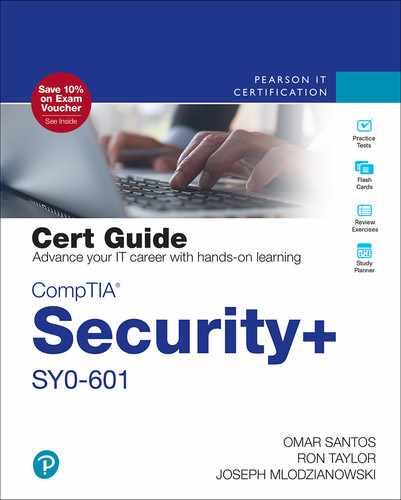Contents at a Glance
Part I: Threats, Attacks, and Vulnerabilities
CHAPTER 1 Comparing and Contrasting Different Types of Social Engineering Techniques
CHAPTER 2 Analyzing Potential Indicators to Determine the Type of Attack
CHAPTER 3 Analyzing Potential Indicators Associated with Application Attacks
CHAPTER 4 Analyzing Potential Indicators Associated with Network Attacks
CHAPTER 5 Understanding Different Threat Actors, Vectors, and Intelligence Sources
CHAPTER 6 Understanding the Security Concerns Associated with Various Types of Vulnerabilities
CHAPTER 7 Summarizing the Techniques Used in Security Assessments
CHAPTER 8 Understanding the Techniques Used in Penetration Testing
Part II: Architecture and Design
CHAPTER 9 Understanding the Importance of Security Concepts in an Enterprise Environment
CHAPTER 10 Summarizing Virtualization and Cloud Computing Concepts
CHAPTER 11 Summarizing Secure Application Development, Deployment, and Automation Concepts
CHAPTER 12 Summarizing Authentication and Authorization Design Concepts
CHAPTER 13 Implementing Cybersecurity Resilience
CHAPTER 14 Understanding the Security Implications of Embedded and Specialized Systems
CHAPTER 15 Understanding the Importance of Physical Security Controls
CHAPTER 16 Summarizing the Basics of Cryptographic Concepts
CHAPTER 17 Implementing Secure Protocols
CHAPTER 18 Implementing Host or Application Security Solutions
CHAPTER 19 Implementing Secure Network Designs
CHAPTER 20 Installing and Configuring Wireless Security Settings
CHAPTER 21 Implementing Secure Mobile Solutions
CHAPTER 22 Applying Cybersecurity Solutions to the Cloud
CHAPTER 23 Implementing Identity and Account Management Controls
CHAPTER 24 Implementing Authentication and Authorization Solutions
CHAPTER 25 Implementing Public Key Infrastructure
Part IV: Operations and Incident Response
CHAPTER 26 Using the Appropriate Tool to Assess Organizational Security
CHAPTER 27 Summarizing the Importance of Policies, Processes, and Procedures for Incident Response
CHAPTER 28 Using Appropriate Data Sources to Support an Investigation
CHAPTER 29 Applying Mitigation Techniques or Controls to Secure an Environment
CHAPTER 30 Understanding the Key Aspects of Digital Forensics
Part V: Governance, Risk, and Compliance
CHAPTER 31 Comparing and Contrasting the Various Types of Controls
CHAPTER 33 Understanding the Importance of Policies to Organizational Security
CHAPTER 34 Summarizing Risk Management Processes and Concepts
CHAPTER 35 Understanding Privacy and Sensitive Data Concepts in Relation to Security
APPENDIX A Answers to the “Do I Know This Already?” Quizzes and Review Questions
APPENDIX B CompTIA Security+ (SY0-601) Cert Guide Exam Updates
Online Elements:
